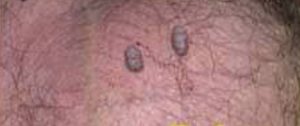Warts / Genital Warts / Verrucas / PPP & Seborrheic Keratosis
Wart Removal
You’ve probably noticed a wart on your body before – many people will get some during their lifetime. Often, they can go away untreated, but it can take a long time, sometimes even years. And while warts don’t cause you any harm, you may find them itchy, painful, or embarrassing. At Perfection Cosmetic we have laser treatment to help remove any unwanted warts.
But what is a wart? It’s a small benign growth that can appear on your palms, knuckles, fingers, and knees. They’re warm and rough to the touch and can come in different sizes. There are also different types of warts, such as genital warts, which again we can help remove.
Types of Warts, Genital Warts & Verrucas
Warts can cover a wide range of areas, so here are the most common types of warts and verrucas which we can help remove using our laser treatment.
Common Wart
Looking like small cauliflowers on your skin, these light brown or white warts most commonly appear on your hands or knees. They’re small in size and will usually be a few millimetres wide.
Plane Wart
Sometimes called a ‘flat wart’. They can appear on your body in a round, smooth shape with a flat top. They commonly appear in groups on your face or on the back of your hands and legs and can be brown, greyish-yellow, or skin coloured.
Plantar Wart (Verruca)
Filiform Wart
These warts appear on lips, eye lids, face or neck.
Periungual Wart
These warts form in the grooves of your nail folds around your nail beds. These warts are covered by your nail or they can create a raise rounded shape around the nail.
Plantar Wart (Verruca)
Verrucas make an appearance on the underside of your feet. The tiny black dots in the middle are where blood has clotted on the surface of your skin, due to standing on the verruca. This can be quite painful when you put weight on them. Because verrucas are on the sole of your feet, they’ll look flat compared to other warts. If you have a cluster of verrucas forming in one area, they can join together. These are called ‘mosaic warts’.
Genital Warts
Genital warts are sexually transmitted infections that appear around the genitals. The first point of the call is to visit a sexual health clinic to help with any symptoms. However, genital warts can also be embarrassing and have a big impact on mental health, so we specialise in genital wart removal which can help you regain your confidence.
Verruca Removal
Verrucas are a different type of wart – a plantar wart – and they tend to only appear on the feet. There are many stories about children picking up verrucas from the local swimming pool as that’s where they are the most contagious, where people are walking around in bare feet. Some verrucas will have a black spot in the middle, caused by bleeding inside the verruca which can happen from repeatedly standing on it.
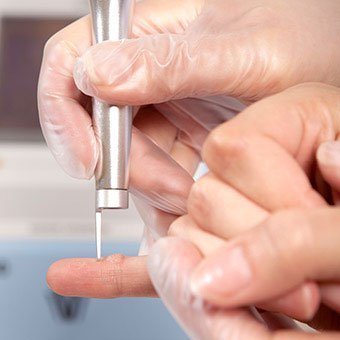

Before & After
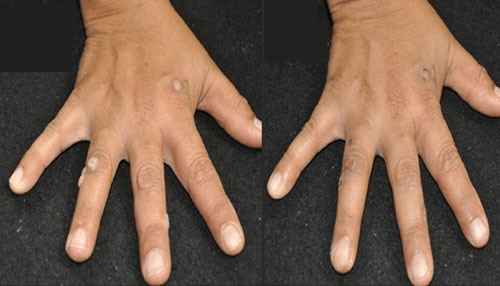
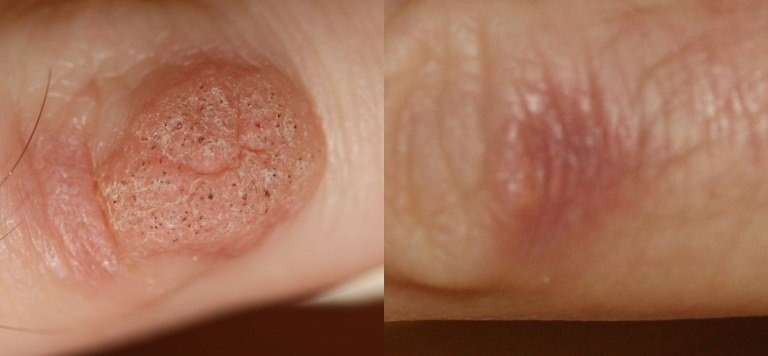
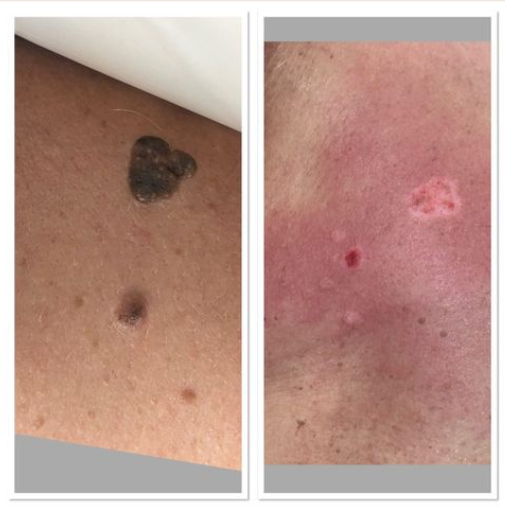
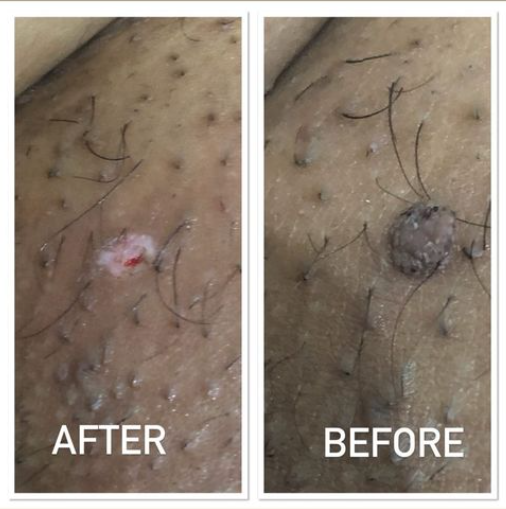
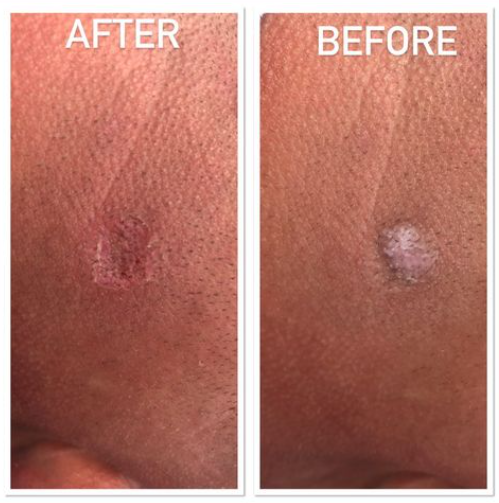
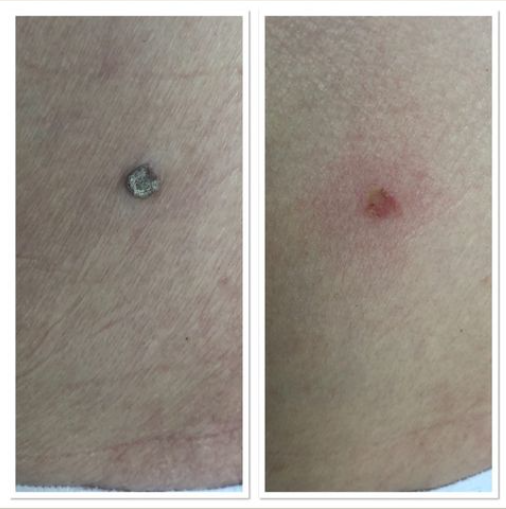
Genital Warts
Genital warts are skin growths that can appear around the penis, vagina, anus, and surrounding areas. They are sexually transmitted and are caused by the human papilloma virus (HPV). Genital warts can appear as skin-colored growths and will form in groups around the private area, in about three or four clusters. They can look like small cauliflower shapes. While it is important to seek medical advice to attack the virus, that won’t always rid you of genital warts. However, our laser treatment can kill genital warts until they no longer appear on your nether regions. Sometimes genital warts appear to look like genital skin tags, however we would diagnose this at your consultation and treat them both at the same time.
Symptoms of Genital Warts
Please find below list of symptoms you may experience if you have genital warts:
- Flesh-Coloured or grey growths around your anus, vagina or upper thigh
- Growths that look similar to cauliflower
- bleeding or itching from your anus or vagina
- Changes to the flow of urine
- You may notice growth maybe internal
How do you know if you have Genital Warts?
Genital warts usually appear as group of bumps or small bumps in the genital area, they can be shaped as a cauliflower or small or large raised bumps. They are common and they are a certain type of HPV which can be treated. The first stage of genital warts are skin coloured small bumps around 2 to 3mm in size. Some individuals may develop couple that can turn into clusters. Genital warts are usually sexual transmitted disease (STD). They are caused by HPV (Human Papillomavirus). Majority of the time HPV does not cause any problems aside beside they can spread and multiply as clusters however in some individuals some types of HPV can cause genital warts abnormal changes in the cells that can sometimes turn into cancer cells which are high risk cells.
PPP (Pearly Penile Papule)
PPP is a very small flesh coloured white lumps that grow around the head of the penis, sometimes underneath the foreskin. When PPP flares up it causes discoloured skin with large yellow pustules scattered around the head of the penis. Sometimes the pustules can darken and turn brown. PPP bumps can be between 1 to 2mm wide and unto 1 to 4mm long. The bumps are in rows around the circumference of the penis. They usually are pearl white in colour or can be yellowish, pinkish or flesh coloured.
Seborrheic Keratosis Removal
Seborrheic keratosis is a benign skin lesion, similar to a mole. Majority of people will have at least one in their lifetime. They normally appear in mid-adulthood and they multiply with age. Growths like seborrheic keratoses are also known as epidermal tumors. This does not mean the lesion are cancerous, however moles and warts are also epidermal tumors. Seborrheic keratosis are clusters of extra cells on the epidermal layer of skin which is the superficial layer of the skin.
Seborrheic keratoses is a epidermal skin tumors that is mostly developed with the natural ageing process, you normally find them on adult and elderly patients. They multiply over time and can spread around the area. It is important to differentiate Seborrheic Karatosis lesions from other benign and malignant lesions.
What does Seborrheic Keratosis Look Like?
Seborrheic keratosis are round or oval-shaped lesion on the skin which slightly raised of the skin which you can feel with your finger, they look waxy or scaly. They are normally brown, but can also be black or slightly tan. They often appear in numbers.
Seborrheic Keratosis are characterized by keratin on the surface layer of the skin, This causes the textural details that often distinguish the growths. Sometimes it looks like small bubbles or cysts within the growth, scabby or wart-like and have ridges and fissures in a brain.
How Do You Get Seborrheic Keratosis?
There is no specific reason to say how the growth appear however but we can look at the circumstances for example with age seborrheic keratoses are especially common in adults and they tend to multiply as people get older. Certain studies show that sun exposure may increase the likelihood of the Seborrheic Keratosis occur. Genetic is a key factor that the lesion can appear frequently in families, which suggests that genetics may play a role. They are not viral or bacterial. They don’t spread and they aren’t contagious.
Seborrheic keratoses usually grow slowly and develop their waxy dry texture over time. If multiple seborrheic keratosis erupt all of a sudden together, it might raise concerns as to why this has all of a sudden happened. This sometime can be a sign of internal cancer. Doctors call it “the sign of Leser Trélat”however it is not proven or explained, your GP might want to screen you for any other signs of internal cancer.
Do seborrheic keratosis cause symptoms?
Usually you don’t, but people sometimes people say they get the following:
-Irritation from friction
-Bleeding
-Itching.
If these symptoms irritate you, you may want to consider to have the growth removed.
How do you tell seborrheic keratosis from melanoma?
Malignant tumour development within Seborrheic keratosis is very rare, though the most commonly develop malignant tumour is a basal cell carcinoma (BCC) and other tumours have been reported that can. They can be black or brown and can appear anywhere on the face and body.
Following are the important differences:
- Seborrheic keratosis often appear in numbers while melanoma is usually single
- Seborrheic keratosis are well-defined while melanoma can have a ragged or blurry border
- Seborrheic keratosis change little and slowly while melanoma can grow and change quickly
- Seborrheic keratosis tend to have texture while melanoma tends to be smooth
- Seborrheic keratosis are uniform while melanoma may be asymmetrical or have more than one colour
What does Cancerous Keratosis look like?
It looks like rough, dry or scaly patch of skin, usually less than 2.5cm in diameter. It is flat to slightly raise area or bumpy on the top layer of the skin. In some cases it is hard, wart like surface. The colour variation is pink, red and brown.
How to Remove Seborrheic Keratosis?
The removal of Seborrheic Keratosis are remove by the following:
– Laser Treatment
– Cryotherapy
– Shaved Excision
– Electrocauterization
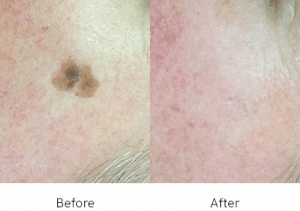
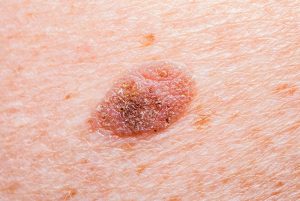

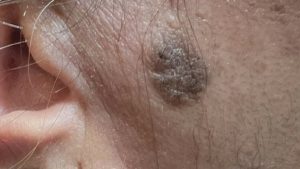
FAQ
Are all growths on the hands and feet warts?
While you may get moles on your hands and feet, the majority of ‘growths’ that appear on your hands and feet are warts. You can come to us here at Perfection Clinic and we can take a look for you. If it’s something that requires medical assistance, we’ll let you know. If it’s something we can treat, then we can arrange a removal procedure.
How long does wart or genital wart removal take?
The good news is that it doesn’t take that long to remove a wart or genital wart. It can be as quick as 15 minutes. Obviously, if you want to get rid of multiple warts, genital warts, or verrucas, it may take a bit longer.
Will I need time off work?
As the procedure doesn’t take long, you could even book it during your lunch break. So no, you won’t need any time off for the actual treatment, nor for the recovery afterward.
Can warts return after removal?
Warts that appear due to HPV, such as genital warts, can reappear if the virus isn’t killed off.
What removal method is best?
Laser technology has been proven to remove warts, genital warts, and verrucas in an efficient way. By killing the blood vessels that feed the wart, it stops it from living on your skin.
What locations are covered?
Verrucas will appear on the bottom of your feet. Genital warts appear around the vagina, penis, and anus. Common warts can appear on other areas of your body, such as the face, hands, arms, knees, and legs.
Are there any side effects?
After your treatment, you may notice the skin is purple or black for a few days. The area where your wart used to be may also appear crusty for a short while.
What laser do you use?
Our CO2 laser can dramatically transform the way your skin looks and is great for removing warts, genital warts, and verrucas. We can also perform the procedures using fibroblast technology too.
How many treatments will I need?
It could take more than one visit to completely remove the wart.
Do I need a consultation?
You can use the form on our website to enquire about treatment and we’ll arrange a follow-up.
I am pregnant. Can I still get treatment?
Yes, you can still get wart removal treatment when you’re pregnant.
Can my genital warts come back?
As genital warts are caused by HPV, they can still come back after laser removal treatment. We can help remove genital warts whenever you need us, but always make sure to seek medical advice to address the virus.
Do I need a referral letter from my GP?
No, just get in touch to speak to one of our practitioners.
Is the removal instant removal on the day of the procedure?
You may notice the wart, verruca, or genital wart reduced in appearance after the first procedure. But you might also need a few visits to make sure we get rid of it completely.
Enquire about this treatment
From £100
Call us on 01204 405114

